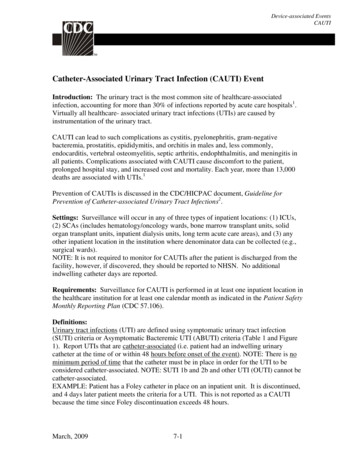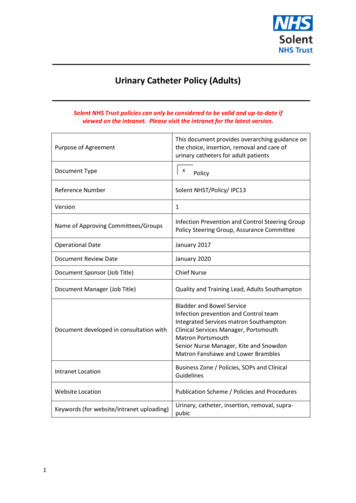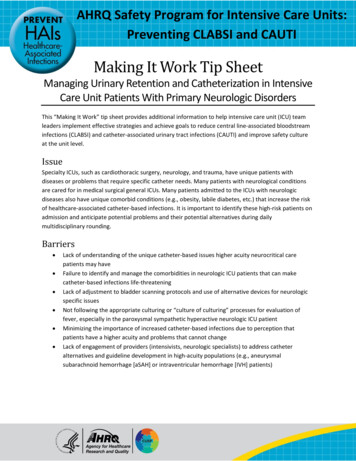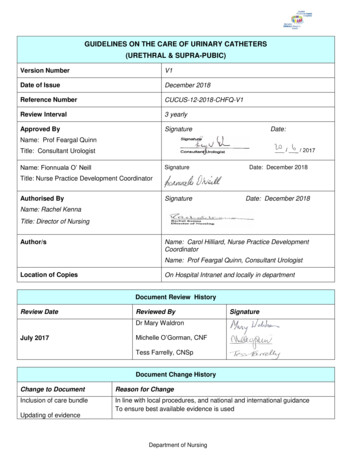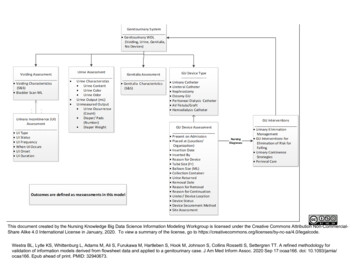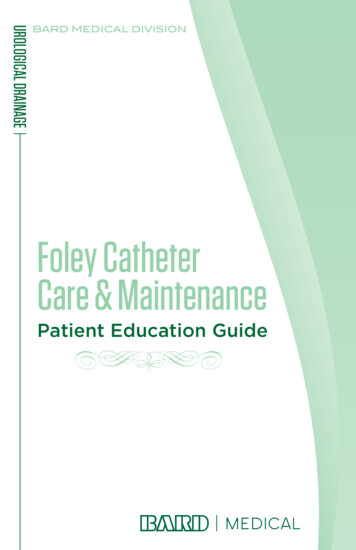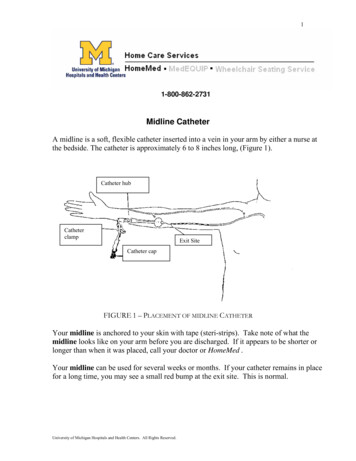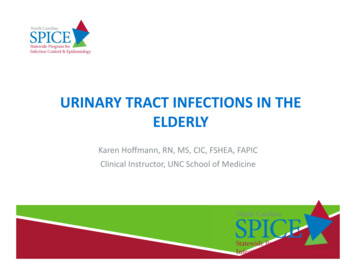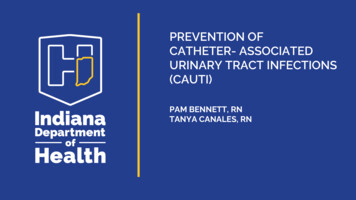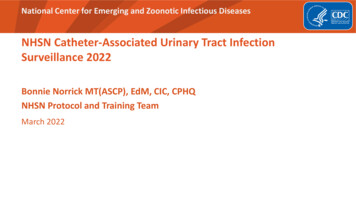
Transcription
National Center for Emerging and Zoonotic Infectious DiseasesNHSN Catheter-Associated Urinary Tract InfectionSurveillance 2022Bonnie Norrick MT(ASCP), EdM, CIC, CPHQNHSN Protocol and Training TeamMarch 2022
ObjectivesWe will discuss CAUTI surveillance. By the end of this lesson, you willbe able to: Apply UTI Protocol through Case Studies Identify Summary Use Data Collection Forms & Table of Instructions2
UTI Burden 2017 - 160,833 CAUTI1– 5.4 CAUTI/1000 discharges 5% Decrease of CAUTI from 2014 – 2017 1 Average cost of a HAI CAUTI: 13,793 1 UTI Ranks 5th HAI in the US21 AHRQ National Scorecard on Hospital-Acquired Conditions Updated Baseline Rates and Preliminary Results 2014-20172 Multistate Point-Prevalence Survey of Health Care–Associated Infections. N Engl J Med 370;13 March 27, 20143
Resources for this discussion CAUTI Surveillance https://www.cdc.gov/nhsn/psc/uti/index.html– Patient Safety Component Manual Chapter 2-Identifying HAI for NHSN Surveillance Chapter 7-Urinary Tract Infection (UTI) Event Chapter 16-NHSN Key Terms UTI Event form UTI Table of Instructions Denominator Forms FAQs4
Using the basics for UTIIWP, DOE, RIT, SBAP . . .
Infection Window PeriodThe first positive urine that isused to meet the definitionalways sets the IWP6
Infection Window PeriodUse only eligible UTI elementswithin the IWPUTI Elements: Urine culture UTI signs/symptoms (s/s) ORmatching blood organism7
UTI Date of Event (DOE) The DOE is the date the first element used to meet anNHSN site-specific infection criterion occurring for the firsttime within the seven-day infection window period First element may be culture OR sign/symptom8
UTI Repeat Infection Timeframe (RIT) 14 day timeframe; Date of event Day 1 No new UTIs are reported (specifically, SUTI, ABUTI) Additional eligible pathogens from urine culturesare added to the event Note the original date of event is mantained Do not change device association during the RIT Any UTI criterion sets an RIT and SBAP includingPOA events and non-catheter-associated events9
Secondary Blood Attribution Period (SBAP) SBAP is the period in which a blood specimen must becollected for a secondary bloodstream infection to beattributed to a primary site infection. Includes the IWP combined with the RIT. Is 14-17 days in length depending upon the date of event.10
Two Scenarios applied to UTI Scenario 1: At least one organism from the blood specimen matches anorganism identified from the site-specific infection (UTI) that is used as anelement to meet the NHSN site-specific infection criterion (UTI) and theblood specimen is collected in the secondary BSI attribution period.(infection window period repeat infection timeframe).OR Scenario 2: An organism identified in the blood specimen is an elementthat is used to meet the NHSN site-specific infection criterion(ABUTI), andtherefore is collected during the site-specific infection window period.11
Location of Attribution Location of attribution: inpatient location where the patient was assignedon the DOE.– Non-bedded patient locations, (for example, Operating Room (OR) orInterventional Radiology (IR)) are not eligible for assignment oflocation of attribution for HAI events.– Location of attribution must be assigned to a location wheredenominator data (for example, patient days, device days) can becollected.12
Transfer Rule Rule of Transfer: If DOE is on the date of transfer or discharge, or the nextday, the infection is attributed to the transferring/discharging location. If the patient was in multiple locations within the transfer rule time frame,attribute the infection to the first location in which the patient was housedthe day before the infection’s date of event. Although the transfer rule does not apply to SSI or LabID events, facilitiesshould always share information of potential HAI events that may occurbefore or following transfers between facilities.13
Site Specific ConceptsNHSN Chapter 7
Indwelling Urinary Catheter (IUC)Key ConceptA drainage tube that is inserted into the urinarybladder (includes neobladder) through the urethra, isleft in place, and is connected to a collection system.This includes a collection system that is used forirrigation of any type or duration (e.g., intermittent,continuous). Also called a Foley catheter15
Neobladder Qualifies for CAUTI surveillance if an IUC inserted throughurethra Made from one’s own small intestine Colonized with intestinal organisms NHSN definitions accounts for contamination of urine specimens– Culture is considered contaminated when more than 2organisms are identified.16
Not an Indwelling Urinary CatheterStraightcatheterizationCondom catheter(Texas catheter)In and Outcatheterization17
Unless an indwelling urethral catheter is also present,the following do not qualify Suprapubic catheterNephrostomy tubesUrostomyIleal conduitPerineal urethostomyUrine from any of these sites can be used in thedetermination of a UTI18
Urine Culture Clarification1. Streak across platethrough the middle.2. Perpendicular streaksacross the first3. Observe single colonies19
Urine Culture ClarificationExcluded organisms Candida species or yeast not otherwise specified, mold,dimorphic fungi or parasites are excluded as organisms in the UTIdefinition therefore blood with these organisms cannot besecondary to UTI Candida auris is a yeastExcluded organisms may be present in urine Urine cultures with yeast can be used as long as there is onebacterium with 105 CFU/ml; no more than 2 organisms (forexample, 105 CFU/ml of E. coli and 105 CFU/ml of C. albicans)20
Urine Culture ClarificationUnusable culture results Urine cultures with 2 organisms are regarded as contaminatedcultures and not used for NHSN UTI surveillance– for example, 105 CFU/ml E. coli, S. aureus and C. albicans 3organisms Urine cultures including “mixed flora*” or equivalent such as “perinealflora”, “vaginal flora”, “normal flora” cannot be used– for example, 105 CFU/ml of E. coli and perineal flora)*The bacteria and other microorganisms that normally inhabit a bodily organor part21
Urine Culture Clarification Urine culture 75,000 – 100,000 CFU/ml is not eligible Organisms of same genus but different species 2 organisms (for example,Pseudomonas aeruginosa and Pseudomonas fluorescens) The same organism with different antimicrobial susceptibilities 1 organism(for example, MRSA and MSSA) IWP is set on the urine specimen collection date not specimen result date Do not add multiple urine cultures together (for example, March 1 urinepositive for 2 organisms and March 2 urine positive for 1 organism would notbe combined to make this an excluded culture due to 2 organisms) Use urine collected from any body location (for example, nephrostomy,suprapubic catheter)22
NHSN Chapter 7UTI Protocol/Criterion
Urinary Tract Infection DefinitionsThere are two specific types of UTI: Symptomatic UTI (SUTI) Asymptomatic Bacteremic UTI (ABUTI)Both types, if catheter-associated, must be reportedas part of any CMS CAUTI reporting requirements!24
SUTI 1a: Catheter-associated Urinary Tract Infection (CAUTI) Criteria(Any Age)1.2.3.Patient must meet 1, 2, and 3 below:Patient had an indwelling urinary catheter (IUC) that had been in place for more than 2consecutive days in an inpatient location on the date of event AND was either: Present for any portion of the calendar day on the date of eventOR Removed the day before the date of eventPatient has at least one of the following signs or symptoms: Fever ( 38.0 C) Suprapubic tenderness**No other recognized cause Costovertebral angle pain or tenderness* Urinary urgency These symptoms cannot be Urinary frequency used when catheter is in place Dysuria Patient has a urine culture with no more than two species of organisms identified, at leastone of which is a bacterium of 105 CFU/mlAll elements of the UTI criterion must occur during the IWP25
SUTI 1b: Non-Catheter-associated Urinary Tract Infection (Non-CAUTI)(Any Age) Patient must meet 1, 2, and 3 below:1. One of the following is true:Patient has/had an indwelling urinary catheter, but it has/had not been in placefor more than 2 consecutive days in an inpatient location on the date of eventOR 2.3.Patient did not have a urinary catheter in place on the date of event nor the daybefore the date of eventPatient has at least one of the following signs or symptoms: Fever ( 38.0C) Suprapubic tenderness**No other recognized cause Costovertebral angle pain or tenderness* Urinary urgency These symptoms cannot be Urinary frequency used when catheter is in place Dysuria Patient has a urine culture with no more than two species of organisms identified,at least one of which is a bacterium of 105 CFU/mlAll elements of the UTI criterion must occur during the IWP26
Knowledge CheckDate Details3/25 Patient admitted to Acute Care hospital fortrauma; IUC inserted3/26 IUC in place3/27 IUC in place3/28 IUC discontinued early morning, @ nooncomplained of urinary frequency3/29 No fever3/30 Elevated wbc’s3/31 Positive urine culture with 105 CFU/ml E coliThe Patient’scomplaint ofurinaryfrequency on3/28 is afterthe IUC wasremoved, socan be usedto meet SUTI.True or False27
SUTI 1a ExamplePatient has an CAUTI 3/31 Positive urine culture setsthe (IWP): 3/28 – 4/3. The 3/28 urinary frequency is firstelement to occur within the IWPtherefore is the date of event. The IUC was in place 2 days onthe date of event CAUTI, HAI.28
Risk Factor Alert29
SUTI 2: CAUTI or Non-CAUTI in patients 1 year of age or lessPatient must meet 1, 2, and 3 below:1.2.Patient is 1 year of age (with or without an indwelling urinary catheter)Patient has at least one of the following signs or symptoms: Fever ( 38 C)Hypothermia ( 36.0 C)( 36.0 C) HypothermiaApnea* Apnea*Bradycardia* Bradycardia*Lethargy**No other recognized cause Lethargy*Vomiting* Vomiting* Suprapubic tenderness*3. Patient has a urine culture with no more than two species of organismsidentified, at least one of which is a bacterium of 105 CFU/mlAll elements of the UTI criterion must occur during the IWP30
SUTI 2 ExampleDateDetails12/23 2 month-old admitted for diarrhea;IUC inserted12/27 Patient vomits x 212/28 Urine culture is positive for E. coli 105 CFU/mlThis meets catheter-associated SUTI 2, date of event 1/27, pathogen E. coli31
Asymptomatic Bacteremic Urinary Tract Infection (ABUTI) (AnyPatient must meet 1, 2, and 3 below:Age)1. Patient with or without an indwelling urinary catheter has no signs or symptomsof SUTI 1 or 2 according to age2. Patient has a urine culture with no more than two species of organismsidentified, at least one of which is a bacterium of 105 CFU/ml3. Patient has organism identified from blood specimen with at least one matchingbacterium to the bacterium identified in the urine specimen OR meets LCBIcriterion 2 (without fever) and matching common commensal(s) in the urine.All elements of the ABUTI criterion must occur during the IWP32
ABUTINote: Catheter-associated ABUTI isreportable IF CAUTI is selected in themonthly reporting plan for this location.33
Asymptomatic Bacteremic UTI (ABUTI) ExampleDateDetails2/20Patient admit for MI, IUC inserted2/21-23No UTI signs/symptoms (s/s)2/24Elevated wbc’s, No UTI s/s, Positive blood withS. aureus and positive urine culture with 105CFU/ml S. aureus2/25-27No UTI s/s2/28IUC removed, Discharged to home34
ABUTI Example 2/24 urine culture sets theIWP: 2/21 – 2/27.No UTI s/s however matchingblood organism within IWP.Meets ABUTI, DOE 2/24.DateSBAPRITFeb 20 AdmitInfection Window PeriodIUC insertedFeb 21no UTI signs/symptomsFeb 22no UTI signs/symptomsFeb 23no UTI signs/symptomsFeb 241Blood culture: S.aureus,Urine culture 10 5 CFU/ml S.aureusno UTI signs/symptomsIUC removed2no UTI signs/symptomsDOEFeb 25IUC in place 2 days on DOEFeb 263no UTI signs/symptomstherefore catheter-associated.Feb 274no UTI signs/symptomsThe matching blood organismFeb 285IUC removed, Discharged to homeis secondary.Catheter-associated ABUTI is reportable if the location is in the facility reporting plan 35
Data Collection form and Table of Instructionsfor UTI Surveillance
https://www.cdc.gov/nhsn/acute -care-hospital/cauti/index.html37
Data Collection Form (57.114)38
Data Collection Form (57.114)39
Example Sensitivity Reporthttps://www.cdc.gov/nhsn/pdfs/gen -support/USP-Alert-current.pdf40
USP form41
Table of Instruction Form (57.114)42
Risk Factors: CAUTIRequired Field: Urinary CatheterOptional: Patient location whereindwelling urinary catheter inserted.Optional: Date indwelling urinarycatheter inserted.Three options:INPLACE- Urinary catheter in place for more than2 consecutive days on the date of eventREMOVE – Urinary catheter in place for more than 2 consecutive days but was removedthe day before the date of eventNEITHER – If no urinary catheter was in place on the day of or the day before the date ofevent OR not in place 2 calendar days on the date of event43
Denominator and Summary Data
Collecting Summary Denominator DataManual CollectionFor all locations, count at the same time each day Number of patients on the inpatient unit Number of patients with an indwelling urinary catheter45
Denominator dataSampling datasum for month46
Collecting Summary Denominator DataOptional alternatives: Electronically collected‒Validate the electronic method against the manual method‒Collect 3 months concurrent data using both methods‒Calculate the data need to be within 5% ( /-) of the manually-collected Weekly Sampling‒ Reduce staff time-estimate indwelling urinary catheter days (IUC)‒ ICU and ward locations with average of 75 IUC days per month‒ Saturday or Sunday - least accurate estimates of denominator data,therefore, these days should not be selected47
Common Mistakes
Common Misapplications of the Protocol1.UTI as secondary infection2.Positive culture on admission automatically Present on Admission (POA)3.UTI signs or symptoms such as fever on admission automatically POA49
#1:Device-associated Module UTI page 7-2UTI as secondary infection-NeverNOTE: UTI is a primary site of infection and cannot be consideredsecondary to another site of infectionWhen a patient meets CAUTI and the same organism is identified in a burn woundculture these are considered 2 sites of infectionWhen a patient meets PNEU event, a CAUTI cannot be classified as a secondary infectioneven though the same organism is identifiedA patient can have 2 different sites of infection50
#2Positive urine culture on admit POA-NO 1/2 Positive urine culture during the POA timeframewithout UTI signs or symptoms nor matching bloodorganism in the IWP is not an event; therefore thisdoes not meet POA. 1/9 Positive urine culture sets the IWP: 1/6– 1/12. 1/10 fever occurs in the IWP, and is used to meetSUTI, DOE 1/9. The IUC was in place 2 days on the DOE thereforemeets SUTI 1a: CAUTI which is HAI.51
#3UTI signs or symptoms onadmission POA-NO The 3/11 urine culture sets the IWP:3/8 – 3/14 The 3/10 fever 380 C can be usedbecause it occurs in the IWP This meets CAUTI, DOE 3/10 Cannot use the 3/1 fever 380 Cbecause it does not occur in the IWP52
Sending Questions to NHSN
Submit UTI case review questions to nhsn@cdc.govSample of Complete NHSN Case review request: Date of AdmissionDate(s) of IUC insertion/removal if applicableAge of patientDate(s) and results of urine cultures including colony countDate(s) and types of UTI signs/symptomsDate(s) and results of any positive blood culturesInclude your determinationDo not include confidential Personal Identifiable Information54
Case Studies
Steps in Investigating a Positive Urine Culture as Possible CAUTI1.Determine the date of the urine culture collection.2.From the date of the urine culture determine the 7-day IWP:3 days before the urine culture, the day of the urine culture and 3 days after for a total of 7 days.3.Determine if all of the elements of the UTI are met during the IWP. If yes, there is an infectionevent. If no, there is no event.4.Next determine the DOE : the date that the first element occurs for the first time within the IWP.5.Is the DOE in the POA time period? If yes, the infection is POA, if no, it is an HAI.(POA time period is defined as the day of admission to an inpatient location, the 2 days beforeadmission, and the calendar day after admission)6.Next (if appropriate) determine if the HAI is device-associated, i.e. CAUTI. If the DOE occurred onor after calendar day 3 of device use in an inpatient location, and the device was in place on thatday or the day before, the HAI is device-associated.56
Applying the basics: Case 1DATE2/2 ED2/3 ADMIT2/42/52/62/72/82/9Infection Window PeriodPatient female 35 years of age IUCinsertedFever 100.90 F IUC day #1Fever 100.80 F IUC day #2urine culture: CNS 105 CFU/mlIUC day #3- Determine the IWP What is the DOE? Is this event catheter associated? Is this event POA or HAI? What is the RIT? What is the SBAP?57
Rationale and Determination: Case 1Meets SUTI 1b: Non-Catheter-Associated UTI The 2/5 positive urine culture sets theIWP: 2/2 - 2/8. The 2/3 fever is the first element to occurwithin the IWP therefore is the DOE;– RIT 2/3-2/16; SBAP 2/3-2/16 Is this POA or HAI. It is Present on admitsince the DOE was on hospital day 1. The IUC was not in place 2 days in theinpatient location on the DOE thereforemeets SUTI 1b: Non-Catheter-AssociatedUTI, and a UTI RIT and SBAP is set58
Transfer Rule: Case 2DateDetails2/2Patient 75 years old seen in ED, IUC inserted2/3Admitted to Critical Care (CC) Temperature 100.2 F2/4Temperature 100.1 F2/5Urine culture collected and positive for 100,000 CFU/mlE. coli, Temperature 100.2F. Transferred to Medical unit2/6Fever 100.82/15IUC removed, Discharged to home59
Rationale and Determination: Case 2 The 2/5 positive urine culture sets IWP:2/2 – 2/8. The temps 2/3 and 2/4 are 100.4 F,cannot be used to meet UTI. There is a fever on 2/6 completing thecriterion. DOE is therefore the 2/5 as the culturewas the first element to occur for the firsttime within the IWP. IUC was in place 2 consecutive day in aninpatient unit CAUTILocation of attribution (LOA) CC 60
COVID-19 Yes; No: Case 3DateDetails12/25Patient admit for respiratory distress, IUC inserted; COVID-19 (SARS CoV-2) positive12/25-28No UTI signs/symptoms12/29Elevated wbc’s, No UTI s/s, Positive blood with S. aureusand positive urine culture with 105 CFU/ml S. aureus12/30-1/1 No UTI s/s1/8-2) negative 1/25IUC removed; COVID-19 (SARS CoVDischarged to home 1/30What is the IWP, DOE, event identified, report COVID-19 Yes or No?61
Case COVID Yes; No Required question for all HAI events occurring on or after January 1, 2022 COVID-19– Answer COVID-19 as ‘YES’ if the patient is lab test confirmed COVID-19 prior to or on the dateof event (HAI). Keep in mind that patients may undergo repeat testing post-treatment and maymove from a ‘confirmed’ to ‘negative’ COVID-19 status.– Answer COVID-19 as ‘NO’ if the most recent lab test prior to or on the date of event (HAI) isnegative.We did not include in our definition a length of time for the patient to be considered 'confirmed';however, we focus strictly on the current hospitalization and the response should be based on thelab test available within the current patient record.It is our hope that the data received over time will enable us to identify the risk of the COVID-19condition on HAIs.62
Case COVID Yes NoDateDetails12/25Patient admit for respiratory distress, IUC inserted; COVID-19(SARS CoV-2) positive12/25-28No UTI signs/symptoms (s/s)12/29Elevated wbc’s, No UTI s/s, Positive blood with S. aureus andpositive urine culture with 105 CFU/ml S. aureus12/30-1/1 Fever 38.0 (IWP 12/26-1/1; DOE 12/29; COVID-19 Yes)1/8-2) negativeDischargedIUC removed, ; COVID-19 (SARS CoVto home63
Summary Reviewed the 2022 UTI Protocol, key concepts and common mistakes Remember‒ Positive urine culture OR UTI s/s on admission does not automatically meet POA‒ UTI is a primary site of infection; cannot be secondary to another site of infection Identified how to count urinary catheter days to determine infectionassociation‒ Catheter count begins on day of insertion and if IUC in place in place prior to admission,begins with admission date to the first inpatient location Applied basic concepts using case studies including the COVID-19Yes/No required, new for 202264
Recipe for good Goulash! Ingredients– 2 lbs lean ground beef or Turkey– 1 large onion, chopped– 30 ounces tomato sauce or juice– 2 cans diced tomatoes– 16 ounces package elbow macaroni cooked as directed In a large pot brown hamburger with onion. Drain grease, add sauce,tomatoes and cooked macaroni. Salt and pepper to taste, simmer for 15minutes Serve in pasta bowls, top with your favorite cheeses65
For any questions or concerns,contact the NHSN Helpdesk at nhsn@cdc.govFor more information please contact Centers for Disease Control and Prevention1600 Clifton Road NE, Atlanta, GA 30333Telephone, 1-800-CDC-INFO (232-4636)/TTY: 1-888-232-6348E-mail: cdcinfo@cdc.gov Web: www.cdc.govThe findings and conclusions in this report are those of the authors and do not necessarily represent the official position of theCenters for Disease Control and Prevention.66
POA events and non-catheter-associated events. 9. Secondary Blood Attribution Period (SBAP) SBAP is the period in which a blood specimen must be collected for a secondary bloodstream infection to be attributed to a primary site infection. Includes the IWP combined with the RIT.
